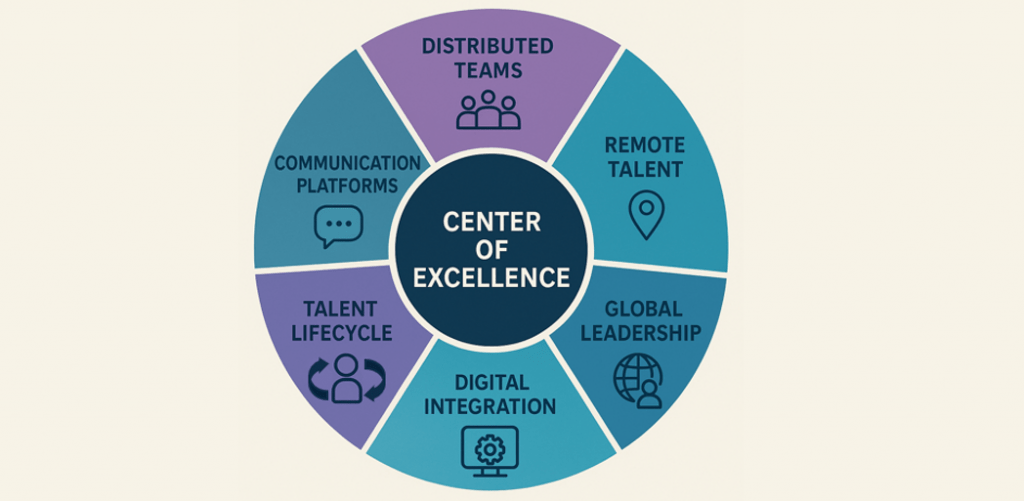Hybrid Centers of Excellence: Managing Global, Distributed, and Remote Talent Pools
The work landscape has undergone a fundamental transformation. The rise of hybrid work models accelerated by global events has ushered in a new era for organizations. Companies can now tap into a truly global talent pool, free from geographic constraints.
This shift offers unprecedented opportunities for innovation and growth but also introduces unique challenges, particularly when managing specialized teams such as Centers of Excellence (CoEs). Traditional, often centralized or shared CoE models must evolve to harness distributed, remote, and global talent while maintaining collaboration and excellence in a hybrid environment.
What is a Center of Excellence in a Distributed Environment?
A Center of Excellence is a specialized team that drives best practices, innovation, and high performance in a specific area of subject matter expertise. In a distributed or hybrid environment, the CoE model becomes a Hybrid CoE, one that combines physical presence with a virtual framework to operate seamlessly across borders.
These Hybrid CoEs are no longer limited to one geographic location. Instead, they leverage:
- Global talent pools for diverse expertise and perspectives.
- Flexible work models for operational agility, and
- Digital collaboration tools to maintain quality and efficiency.
Defining Digital Centers of Excellence for Global Teams
A Digital Center of Excellence (Digital CoE) is a hub that drives enterprise-wide digital transformation. It builds subject matter expertise, standardizes best practices, and accelerates technology adoption, functioning without the limitations of a traditional CoEs
- Technology-driven collaboration: Enterprises can leverage platforms like Miro, Asana, or Microsoft Teams to enable seamless teamwork and knowledge sharing.
- Outcome-focused operations: Performance should be measured by results and impact, rather than hours worked.
- Inclusive practices: Establish frameworks that bridge cultural, linguistic, and time-zone differences to ensure equity and collaboration.
- Adaptive leadership: Leaders should be equipped with the skills and training needed to effectively manage and empower distributed teams.
Digital CoEs act as hubs for innovation, strategy alignment, and capability building regardless of where team members are physically located.

Managing Global and Remote Talent in Hybrid CoEs
While hybrid models present tremendous potential, managing them requires tackling unique challenges and opportunities. Success depends on creating intentional structures that balance flexibility with accountability.
Challenges
- Communication Complexity – Coordinating across time zones demands intentional strategies and robust tools. Clear protocols and standardized platforms help reduce misunderstandings and ensure seamless collaboration.
- Culture and Cohesion – Building a sense of belonging among individuals who rarely meet in person requires proactive engagement. Virtual team-building activities and recognition initiatives can strengthen connection and trust.
- Performance Equity – Ensuring fair evaluation and equal access to opportunities for all employees. Transparent KPIs and bias-free assessment methods are essential to maintain fairness across distributed teams.
- Onboarding and Development – Integrating new hires into a distributed team with structured, engaging processes. Continuous learning pathways and mentorship programs help accelerate integration and career growth.
Opportunities
- Expanded Talent Pool – Accessing to global expertise at potentially lower costs. This allows organizations to tap into niche skills and foster greater diversity in their workforce.
- Boosted Productivity – Well-designed hybrid setups improve focus and efficiency. Employees can optimize their work schedules to match peak productivity times.
- Improved Retention – Flexibility enhances employee satisfaction and loyalty. Offering personalized work arrangements creates stronger long-term commitment to the organization.
Best Practices in Building a Center of Excellence for Distributed Teams
To thrive in a hybrid model, CoEs need intentional strategy and execution across four core areas:
Reimagine Communication and Collaboration
- Define Communication Norms – Establish clear guidelines for using synchronous and asynchronous tools.
- Leverage Technology – Use digital whiteboards, project management platforms, and even VR tools for engagement.
- Plan In-Person Gatherings – Use occasional meetups for brainstorming, relationship-building, and alignment.
Foster an Inclusive and Resilient Culture
- Cultural Sensitivity Training – Equip teams to navigate diverse communication styles.
- Promote Psychological Safety – Encourage open feedback and idea-sharing without fear.
- Virtual Team Building – From online coffee chats to collaborative games, keep connections strong.
Optimize Performance Management and Talent Development
- Measure Outcomes, Not Hours – Focus on deliverables and impact over attendance and number of hours.
- Redesign Performance Reviews – Include self-assessments, peer feedback, and qualitative metrics.
- Invest in Continuous Learning – Offer virtual courses, mentorship programs, and cross-training.
- Address Proximity Bias – Ensure promotions and recognition are equitable across all locations.
Enable Leadership Adaptability and Empowerment
- Train Managers for Distributed Leadership – Skills in emotional intelligence, digital communication, and inclusivity are key.
- Empower Local Leadership – Grant autonomy to regional leads to adapt strategies to local contexts.
- Flexibility with Accountability – Clear deliverables and timelines balanced with work-style freedom.
Looking Ahead: The Future of Hybrid CoEs
As technology advances, Hybrid CoEs will increasingly integrate innovative solutions that enhance both efficiency and impact. By embedding technology at the core, Hybrid CoEs can scale faster, respond to market shifts with agility, and deliver greater value across the enterprise.
- AI-powered workforce analysis: Advanced analytics will help leaders identify skill gaps, forecast future needs, and optimize team structures. This data-driven approach ensures better decision-making and more effective allocation of talent.
- Next-gen collaboration platforms: From immersive virtual workspaces to integrated communication hubs, these tools will enable seamless teamwork across geographies. Such platforms help foster innovation while minimizing the friction of distance and time zones.
- Advanced talent acquisition systems: AI-enabled recruiting solutions will target niche skill sets worldwide, shortening hiring cycles and improving quality of hire. This global reach opens access to specialized expertise that may not exist in a single market.
Organizations that adapt early to these shifts will not only attract and retain top talent but also accelerate innovation and secure a sustained competitive edge in the evolving global marketplace.
Conclusion
Hybrid Centers of Excellence offer a powerful framework for leveraging global, distributed, and remote talent pools. With enhanced communication, inclusive culture-building, results-focused performance management, and adaptive leadership, organizations can overcome the challenges of the hybrid era and unlock unprecedented growth and innovation.
The future of CoEs is hybrid those who embrace this reality will lead the way in sustained, global success.




